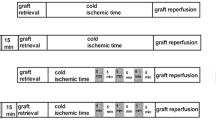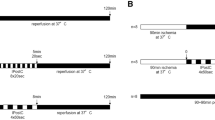Abstract
Ischemia–reperfusion (I/R) cannot be avoided in liver transplantation procedures, and apoptosis is a central mechanism of cell death after liver reperfusion. Protective effect of recombinant erythropoietin (rhEPO) on liver apoptosis has not been clearly investigated. This work investigated intraportal (IP) rhEPO-protective effect in a rat model of hepatic I/R-induced apoptosis and its appropriated time and dose of administration. Eight groups were included (n = 10/group): sham-operated, I/R (45 min ischemia and 2 h reperfusion), preconditioned rhEPO I/R (24 h or 30 min before ischemia), and postconditioned rhEPO I/R (before reperfusion) using two different rhEPO doses (1,000 and 5,000 IU/kg). When compared with the sham-operated group, the I/R group showed significant increase of serum levels of aspartate and alanine aminotransferases (AST, ALT), hepatic caspase-9 activity(894.99 ± 176.90 relative fluorescence units (RFU)/mg/min versus 458.48 ± 82.96 RFU/mg/min), and Fas ligand (FasL) expression, histopathological damages, and significant decrease in the antiapoptotic Bcl-xL/apoptotic Bax ratio(0.38 ± 0.21 versus 3.35 ± 0.77) rhEPO-improved ALT and AST but failed to reduce FasL expression in all groups compared with the I/R group. Thirty minutes and 24 h preconditioning with rhEPO (1,000 IU/kg) increased Bcl-xL/Bax ratio and reduced caspase-9 activity, and the same effect was observed when higher dose was given 24 h before ischemia. Preconditioning was more effective than postconditioning in improving caspase-9 activity, and no dose-dependent effect was observed. In conclusion, single IP rhEPO injection 30 min before ischemia has an advantage over rhEPO postconditioning in improving post-hepatic I/R-induced apoptosis with no additional time- and dose-dependent effects which may provide potentially useful guide in liver transplantation procedures.





Similar content being viewed by others
References
Allan LA, Morrice N, Brady S, Magee G, Pathak S, Clarke PR (2003) Inhibition of caspase-9 through phosphorylation at Thr 125 by ERK MAPK. Nat Cell Biology 5:647–654
Bramey T, Freitag P, Fandrey J, Rauen U, Pamp K, Erhard J, Frede J, Groot H, Petrat F (2009) No evidence for protective erythropoietin alpha signalling in rat hepatocytes. BMC Gastroenterol 9:26
Brines M, Cerami A (2006) Discovering erythropoietin's extra-hematopoietic functions: biology and clinical promise. Kidney Int 70:246–250
Cai Z, Manalo DJ, Wei G (2003) Hearts from rodents exposed to intermittent hypoxia or erythropoietin are protected against ischemia–reperfusion injury. Circulation 108:79–85
Chattopadhyay P, Verma N, Verma A, Kamboj T, Ali Khan N, Wahi AK (2008) l-arginine protects from pringle maneuver of ischemia–reperfusion induced liver injury. Biol Pharm Bull 31:890
Chomkczynski P, Sacchi N (1987) Single step method for RNA isolation by the acid guanidinum thiocyanate–phenol–chloroform method. Anal Biochem 162:156–160
Doi Y, Hamazaki K, Yabuki M, Tanaka N, Utsumi K (2001) Effect of HSP70 induced by warm ischemia to the liver on liver function after partial heap. Hepatogast-Roenterology 48:533–540
Ehrenreich H, Hasselblatt M, Dembowski C, Cepek L, Lewczuk P (2002) Erythropoietin therapy for acute stroke is both safe and beneficial. Mol Med 8:495–505
Fesik SW, Shi Y (2001) Controlling the caspases. Science 294(5546):1477–1478
Friedrich D, Kirsten E, Achim K, Stefanie W, Arno S, Nina R, Patrick E, Philipp D, Alexandra KK, Oliver K, Theodor J (2007) Protection from hepatic ischemia reperfusion injury and improvement of liver regeneration injury and impairment of liver regeneration by lipoic acid. Shock 27:644–651
Ghezzi P, Brines M (2004) Erythropoietin as an antiapoptotic, tissue-protective cytokine. Cell Death Differ 11:S37–S44
Greif F, Ben-Ari Z, Taya R, Pappo O, Kurtzwald E, Cheporko Y, Ravid A, Hochhauser E (2010) Dual effect of erythropoietin on liver protection and regeneration after subtotal hepatectomy in rats. Liver Transpl 16(5):631–638
Gujral JS, Bucci TJ, Farhood A, Jaeschke H (2001) Mechanism of cell death during warm hepatic ischemia–reperfusion in rats: apoptosis or necrosis? Hepatol 33:397–405
Hartkorn A, Hoffmann F, Ajamieh H, Vogel S, Heilmann J, Gerbes AL, Vollmar AM, Zahler S (2009) Antioxidant effects of xanthohumol and functional impact on hepatic ischemia reperfusion injury. J Nat Prod 72:1741–1747
Hauet T, Mothes D, Goujon JM (1997) Trimetazidine prevents renal injury in the isolated perfused pig kidney exposed to prolonged cold ischaemia. Transplantation 64:1082–1086
Hochhauser E, Pappo O, Ribakovsky E, Ravid A, Kurtzwald E, Cheporko Y, Lelchuk S, Ben-Ari Z (2008) Recombinant human erythropoietin attenuates hepatic injury induced by ischemia/reperfusion in an isolated mouse liver model. Apoptosis 13:77–86
Hu G, Lü X (2005) Effect of normothermic liver ischemic preconditioning on the expression of apoptosis-regulating genes C-jun and Bcl-xL in rats. World J Gastroenterol 11:2579–2582
Jaeschke H (2000) Reactive oxygen and mechanisms of inflammatory liver injury. J Gastroenterol Hepatol 15:718
Klemm K, Eipel C, Cantré D, Abshagen K, Menger MD, Vollmar B (2008) Multiple doses of erythropoietin impair liver regeneration by increasing TNF-α, the Bax to Bcl-xL ratio and apoptotic cell death. PLoS ONE 3:3924
Kroemer G, Reed JC (2000) Mitochondrial control of cell death. Nat Med 6:513–519
Lipsic E, Schoemaker RG, van der Meer PVoors AA, van Veldhuisen DJ, van Gilst WH (2006) Protective effects of erythropoietin in cardiac ischemia: from bench to bedside. J Am Coll Cardiol 48:2161–2167
Nakajima H, Mizuta N, Fujiwara I, Sakaguchi K, Ogata H, Magae J, Yagita H, Koji T (2008) Blockade of the Fas/Fas ligand interaction suppresses hepatocyte apoptosis in ischemia–reperfusion rat liver. Apoptosis 13:1013–1021
Oh K-W, Currin RT, Lemasters JJ (2000) Kupffer cells mediate increased anoxic hepatocellular killing from hyperosmolarity by an oxygen- and prostaglandin-independent mechanism. Toxicol Lett 117:95–100
Schmeding M, Hunold G, Ariyakhagorn V, Rademacher S, Boas-Knoop S, Lippert S, Neuhaus P, Neumann UP (2009) Erythropoietin reduces ischemia–reperfusion injury after liver transplantation in rats. Transpl Int 22:738–746
Schmeding M, Neumann UP, Boas-Knoop S, Spinelli A, Neuhaus P (2007) Erythropoietin reduces ischemia–reperfusion injury in the rat liver. Eur Surg Res 39:189–197
Schmeding M, Neumann UP, Boas-Knoop S, Spinelli A, Neuhaus P (2007) Erythropoietin reduces ischemia–reperfusion injury in the rat liver. Eur Surg Res Clin Exp Surg 39:189–197
Sepodes B, Maio R, Pinto R, Sharples E, Oliveira P, Mconald M, Yaqoob M, Thiemermann C, Mota-Filipe H (2006) Recombinant human erythropoietin protects the liver from hepatic ischemia reperfusion injury in the rat. Trans Int J 19:919–926
Vesey DA, Cheung C, Pat B, Endre Z, Gobe G (2004) Erythropoietin protects against ischemic acute renal injury. Nephrol Dial Transplant 19:348–355
Yilmaz S, Ates E, Tokyol C, Pehlivan T, Erkasap S, Koken T (2004) The protective effect of erythropoietin on ischemia/reperfusion injury of liver HPB 6:169–173
Author information
Authors and Affiliations
Corresponding author
Rights and permissions
About this article
Cite this article
Shawky, H.M., Younan, S.M., Rashed, L.A. et al. Effect of recombinant erythropoietin on ischemia–reperfusion-induced apoptosis in rat liver. J Physiol Biochem 68, 19–28 (2012). https://doi.org/10.1007/s13105-011-0114-2
Received:
Accepted:
Published:
Issue Date:
DOI: https://doi.org/10.1007/s13105-011-0114-2




